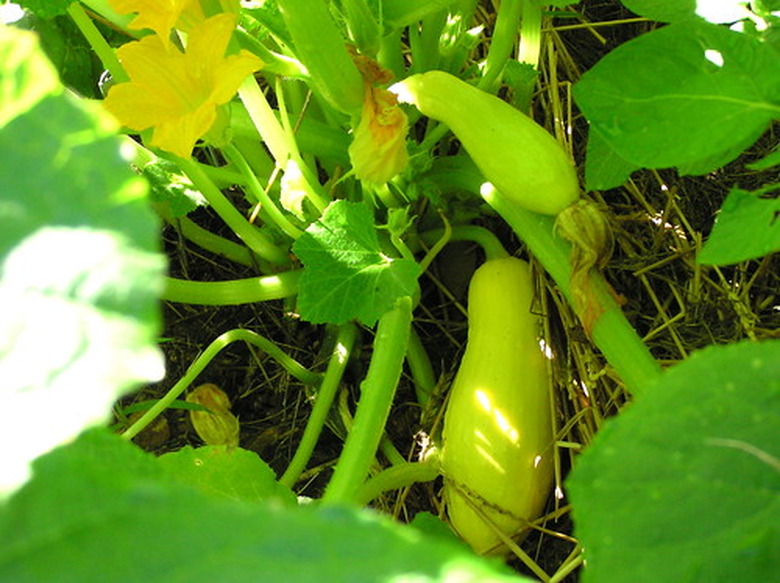The Life Cycle Of A Squash Plant
Squash plants can be one of the most rewarding vegetables in the garden, though growing them has its challenges. Summer and winter squashes are all members of the cucurbit family, which has many pests and quite a few specific cultivation requirements. Pest control can be achieved through careful planting arrangements and watchful vigilance; organic farmers will have the best results through the tedious job of picking off bugs by hand. Beyond this, consistently hot growing temperatures are the non-negotiable requirement for successfully growing squashes of all kinds.
About Squash Plants
Squash plants include summer squashes like zucchini, yellow squash and pattypan squash; winter squashes, like acorn, butternut and pumpkin; and other . The majority of plants in this category are characterized by sprawling growth habits, large male and female flowers, climbing tendrils and hollow vines with spines.
Pests include the cucumber squash beetle, which is identifiable by alternating black-and-white or black-and-yellow stripes. The common squash vine borer is another serious pest, which kills plants by laying eggs inside the base of the vine. After hatching, the borer larvae eat the plant from the inside out, causing sudden and catastrophic plant death.
- Squash plants can be one of the most rewarding vegetables in the garden, though growing them has its challenges.
- Summer and winter squashes are all members of the cucurbit family, which has many pests and quite a few specific cultivation requirements.
All squash plants require warm soil and air temperatures for successful germination and fruit set. The onset of cold weather will kill the plant.
Squash Seed Germination
Squash seeds are all relatively large, and are usually flat and oblong or oval shaped. Seeds require soil temperatures of over 70 degrees for good germination; optimal air temperature for germination is around 95 degrees, and seedlings will emerge in 3 to 4 days at temperatures this high.
After germination, the plant sends up a stem with seed leaves, or thick, stubby structures that were once the flesh of the interior of the seed. The plant will put on its first true leaves several days after the seed leaves emerge; true leaves look like smaller versions of squash foliage.
If seeds are germinated indoors in peat pots, plants should have at least one or twotrue leaves before being placed in the outdoor garden.
- All squash plants require warm soil and air temperatures for successful germination and fruit set.
- After germination, the plant sends up a stem with seed leaves, or thick, stubby structures that were once the flesh of the interior of the seed.
Squash Vine Growth
The squash vines must have consistently high temperatures for good rates of growth. While the plant requires consistent water in order to bloom and set fruit, cold soil and air temperatures will inhibit growth and may exacerbate problems like powdery mildew on the leaves, poor pollen production and even root rot.
Summer squashes generally have shorter, more compact vines, growing to around 2 feet. Winter squashes are known best for their huge sprawling habits – pumpkins can grow vines in excess of 15 feet or more. For gardeners with space issues, long-vined squashes can be trained to grow up a trellis.
Squash Flowering and Fruiting
All squashes produce separate male and female flowers, and fruit set is accomplished by insect pollination. Bees, flies and other flying insects carry the male pollen to the female flower. If the ovary of the female flower is successfully fertilized, a squash fruit will begin to grow just behind the flower. The flower dries up and falls off as the squash develops.
- The squash vines must have consistently high temperatures for good rates of growth.
- If the ovary of the female flower is successfully fertilized, a squash fruit will begin to grow just behind the flower.
Summer squashes can produce fruits in several weeks, whereas most winter squashes take a few months to mature. Gardeners who trellised their vines should be prepared to support the growing fruit with a homemade sling to ensure the vegetable does not slip from the vine prior to full ripening.
Saving Seed
Depending on the variety, gardeners may be able to save seed from ripe squashes for the following year's garden. Check the packet or growing instructions: some plants will not grow true to type—the same from year to year—from seed, and new seed should be purchased each year. In general, heirloom varieties typically grow true to type, while hybrid varieties do not.
